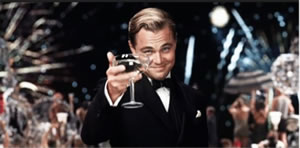Not So 'Leafy' After All
Chiswick the inspiration for Gatsby's bacchanalian parties?
|
The Great Gatsby is synonymous for generations of readers, filmgoers and A-Level students with the heady days of the Roaring Twenties, as the American super-rich flaunted the constraints of Prohibition to live lives of intoxicating - and ultimately dangerous - excess.
Gatsby, published in 1925, conjures up images of raucous parties, staged in grandiose mansions swinging to the tune of Jazz Age musicians. To put it mildly, such images are not often associated with Chiswick. However, according to a recent article on the Guardian web site, the unlikely (and admittedly somewhat indirect) influence behind Fitzgerald's party scenes, most recently portrayed in Baz Lurhmann's Hollywood movie, was a particularly rambunctious fête hosted in Edwardian W4.
The article argues that one of the most significant models Fitzgerald used for Gatsby was a 1913 novel by a French author writing under the pen-name Alain-Fournier, entitled Le Grand Meaulnes. The novel, Alain-Fournier's only completed work, shares a number of similarities with The Great Gatsby, but one chapter from Meaulnes which made a particularly clear impression on Fitzgerald describes the young protagonist finding love when stumbling upon a lavish party held at a old and mysterious manor house.
Alain-Fournier, whose real name was Henri Alban-Fournier, spent the summer of 1905 working at the Sanderson wallpaper company, just across from the Barley Mow Passage in Chiswick. Alban-Fournier's time in London was not very successful. Nonetheless, having returned to France, he did seem to hold one memory of England close to his heart: a party put on by his employers at Sanderson & Sons as a treat for workers. The fete, held at the Sanderson's social club on Chiswick High Road, would inspire the soiree scene in Le Grand Meaulnes, which in turn would provide the basis for Fitzgerald's glamorous Twenties festivities.
Sanderson, a wallpaper factory, owned a social club for employees on the High Road nicknamed 'Bleak House'. According to the Brentford and Chiswick Local History Society, the club boasted a bowling green and reading rooms. There was also a dining room, where meals were served at cost price, and in addition events were regularly held at the House, ranging from swimming galas to flower shows. Plenty on offer for a labourer after a long day at work, then, but Jay Gatsby or Daisy Buchanan would probably have been unimpressed.
September 26, 2014
